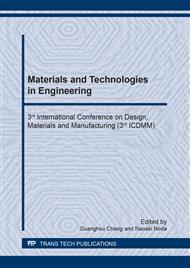p.79
p.84
p.89
p.94
p.101
p.109
p.114
p.123
p.128
Design, Fabrication and Analysis of a Novel Membrane Dielectric Elastomer In-Plane Actuator
Abstract:
The emerging field of soft robots offers the prospective of applying soft actuators as artificial muscles, replacing traditional actuators based on hard materials. Dielectric elastomers (DE), one class of electro-active polymers, represents an attractive technology for the realization of mechatronic actuators, due to their light weight, high energy efficiency and scalability. This work aims at investigating and characterizing a novel design of membrane DE in-plane actuator by magnetic mechanism. A nonlinear dynamic model of the dielectric elastomer actuator (DEA) is established and corresponding material parameters are identified. Natural frequency and response speed of DEAs are studied. It demonstrates that larger stretch and higher response speed can be realized by the proposed DEA.
Info:
Periodical:
Pages:
101-108
Citation:
Online since:
December 2018
Authors:
Keywords:
Price:
Сopyright:
© 2018 Trans Tech Publications Ltd. All Rights Reserved
Share:
Citation:


